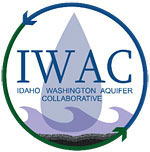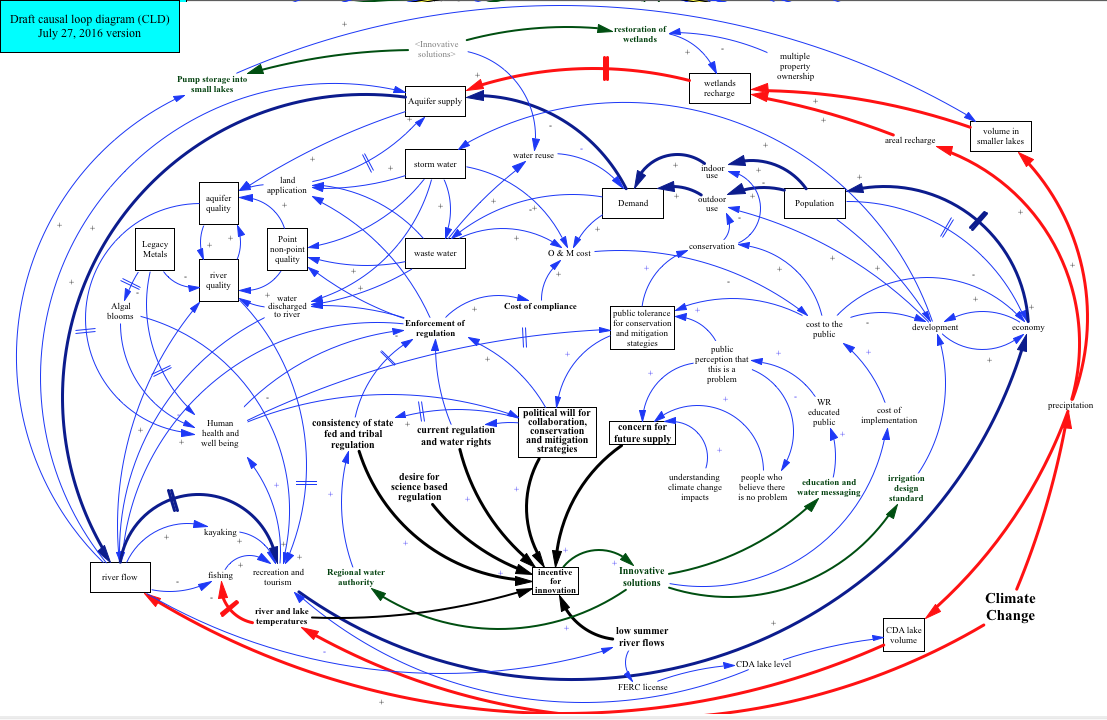Summer 2016 – Written and prepared by: Melanie Thornton, WSU PhD Candidate
Download Report
Dates and Location
Two planning workshops took place on July 12 and August 9, 2016 at Liberty Lake Sewer & Water District Conference Room in Liberty Lake, WA. Each workshop was 3 hours in length.
Workshop Team
The members of Idaho Washington Aquifer Collaborative (IWAC) decided to plan two summer workshops to expand a regional discussion on future water resources planning. The planning team consisted of Mike Galante, President of IWAC, Tonilee Hanson, Program Manager of SAJB, Dr. Allyson Beall King, Clinical Professor at Washington State University (WSU), and Melanie Thornton, PhD candidate at WSU. Allyson and Melanie facilitated each workshop and Kayla Wakulich, Masters student at WSU, was a participant observer and record keeper.
Agenda: July Workshop
This workshop included a facilitated discussion and causal mapping exercise on problems and issues, barriers and potential solutions to integrated water resource management in the SVRP.
- Futures Triangle: problems, barriers, and plausible futures
- Causal Loop Diagramming
- Next Steps
Agenda: August Workshop
This workshop included a facilitated discussion on potential solutions to, and action items for, integrated water resource management in the region that have been identified and described within the integrated causal map.
- Critical Uncertainties: developing strategies for plausible futures
- Update on Causal Loop Diagram
- What, So What, Now What: reflection on progress to date and discussion of next steps
Participants
The July workshop was attended by 12 individuals from: City of Spokane Valley, Hayden Lake Irrigation District, Liberty Lake Sewer and Water District, Model Irrigation District, Idaho Water Engineering, North Kootenai Water & Sewer District, Spokane Aquifer Joint Board, Spokane County Water District No. 3, Spokane County Environmental Services, and WA Department of Health – Division of Drinking Water.
The August workshop was attended by 19 individuals from: Spokane Aquifer Joint Board, North Kootenai Water & Sewer District, WA Department of Health- Division of Drinking Water, Panhandle Health District, ID Department of Environmental Quality, City of Post Falls, Spokane County Water District No. 3, Spokane County Environmental Services, Spokane County Conservation District, City of Spokane, Liberty Lake Sewer and Water District, Idaho Water Engineering, ID Department of Water Resources, City of Spokane Valley, Consolidated Irrigation District, East Greenacres Irrigation District, Spokane Regional Health District, and the Spokane Tribe.
Workshop Overview
July Workshop Overview
The July workshop began by Mike addressing the workshop participants with an overview of the purpose of the workshop, including the challenges and problems to regional water resources and the opportunity to develop solutions and recommendations for bi-state water planning. Allyson gave additional background on the challenges to brainstorming ideas and potential solutions to an uncertain and unknown future. In addition, Allyson gave an introductory overview of the challenges and benefits of causal loop diagramming.
Melanie led the group into the first activity called Futures Triangle. The basic idea is that there are three dimensions that help explore plausible futures — past/barriers, the present and the pull to the future. Each participant worked individually to answer the following questions:
- What are 5 problems related to water resources in the region?
- What are 5 barriers to fixing the issues you previously mentioned?
- What are 5 hopes and fears for the future?
The next portion of the workshop the participants split into two groups, and discussed items from the first activity and translated them in causal loop diagrams (CLD) of the SVRP water resource system (see draft CLD below). A CLD is a diagram that helps individuals visualize how different variables are interrelated within a system.
The workshop concluded with a roundtable debrief and discussion about next steps. In addition, the participants had a critical discussion about who should attend the next workshop in August.
August Workshop Overview
The August workshop began by Allyson providing background and overview of the first workshop, which included expanding the conversation and moving from challenges and barriers to strategies and actions.
Melanie led the Critical Uncertainties and Scenario Matrix session. This session aimed to help a group develop strategies and build capacity to respond to future challenges. Melanie invited the workshop participants to identify and explore the most challenging factors to predict or control related to regional water planning. In addition, each group (total 4) was prompted to formulate strategies that would help them successfully develop and implement a regional water plan. Each group developed a scenario matrix (4 quadrants), named each quadrant and wrote a thumbnail scenario for the group’s preferred quadrant (see table below). Then, each group brainstormed three strategies that would help the group operate successfully in the scenario that they had described.
Scenarios to Causal Loop Diagrams was the next portion of the workshop, and Allyson prompted the group to translate their scenarios and strategies into the current draft version of causal loop diagram. In addition, workshop participants had the opportunity to revise and edit the current draft version of the CLD.
The last part of the workshop, Melanie led the group through a debrief and discussion exercise called What, So What, Now What. This session allowed participants to reflect on the experience, which progressed into making sense of the workshop discussion, and to develop action items and next steps. The group was prompted with a series of questions:
- What? What happened? What did you notice, what factors or observations stood out?
- So What? Why is that important? What patterns or conclusions are emerging?
- Now What? What actions make sense?
The workshop concluded with a roundtable discussion about next steps for the workshops and future actions items.




